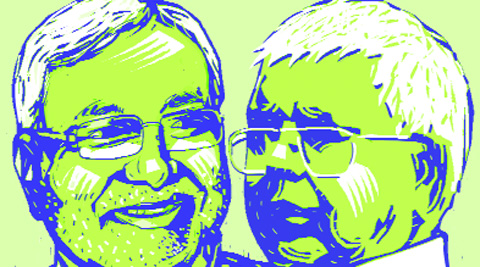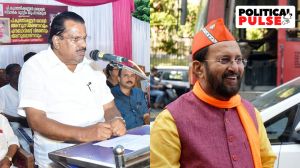- India
- International
Bihar, a new story
Nitish has joined hands with Lalu. Together, they might just provide an alternative to an ascendant BJP.
 Lalu and Nitish have so far refrained from meeting each other, even at iftar parties hosted by CM Jeetan Ram Manjhi. They are set to announce their alliance formally on Wednesday. Source: PTI
Lalu and Nitish have so far refrained from meeting each other, even at iftar parties hosted by CM Jeetan Ram Manjhi. They are set to announce their alliance formally on Wednesday. Source: PTI
BY: Chinmaya Kumar and Abhishek Choudhary
Nitish has joined hands with Lalu. Together, they might just provide an alternative to an ascendant BJP.
If analysts in the media are to be believed, Nitish Kumar’s political future in Bihar has gone to the gutter. As if last year’s blunder of jettisoning ties with the BJP (for which he paid heavily in the Lok Sabha elections) wasn’t enough, they say, this time he’s done something that might sink him for ever — a tie-up with Lalu Prasad, till very recently his bête noire. While the Congress is also part of this tripartite alliance for the assembly bypolls for 10 seats to be held on August 21, the main focus of discussion has been the JD(U)’s joining of hands with the RJD.
It’s easy to see desperation in this move, on the part of both the JD(U) and the RJD. The BJP’s alliance with Ram Vilas Paswan’s LJP and Upendra Kushwaha’s RLSP has made the NDA very strong in Bihar. For the Lok Sabha election, apart from its traditional upper-caste supporters, the coalition was able to win considerable support from the OBCs, EBCs and Dalits, communities that earlier voted mostly for either Nitish or Lalu. This existential crisis of the two strong regional parties — both of which are also presently beset by internal rivalries — has forced them to come together to consolidate the anti-BJP votes for the upcoming assembly bypolls and, especially, the assembly elections due in the latter half of 2015.
So far, the story is simple. It’s here that the myth-making begins. The first argument is that Nitish has eschewed his development agenda and fallen back on the pre-2005 days of caste politics. During his chief ministership with the BJP as partner, while Nitish did achieve a lot in terms of resurrecting basic institutions and stimulating economic growth, he was also always looking for ways to carve out new caste coalitions for his party — for example, reservations for EBCs in panchayati raj institutions, the creation of “Mahadalits” and the introduction of a wide range of welfare schemes specifically for them. There were also occasions when he tried his best to appease upper-caste

supporters, such as putting aside the recommendations of the Bandyopadhyay Committee on land reforms. The summary is this: caste politics and development need not necessarily be mutually exclusive.
While the JD(U)’s alliance with the RJD could be called regressive (given that the party originated from an anti-Lalu plank), its alliance with the BJP was ideologically perhaps much more contradictory. Their support base and interests were diametrically opposite, and the fact that they were together for more than 17 years seems, in retrospect, a miracle. One of the reasons the JD(U)-BJP alliance worked was because both parties had a common enemy in Lalu and agreed to compromise with their ideological leanings to defeat him.
Another myth is that Nitish’s alliance with Lalu would bring back the “goonda raj” in Bihar. The assumption is that criminality and corruption is inherent to the RJD, while the JD(U) and BJP, which have performed better in governance, must be relatively “clean” parties. The fact is that the JD(U) and BJP have always had — and continue to do so — an equal number of candidates with serious criminal charges against them. During the JD(U)-BJP coalition government, it was Nitish’s strong leadership that kept hooliganism under check. If he could check the criminals from the JD(U) and BJP and tame the BJP’s tendency to pursue communal politics, would it not be fair to assume that he would develop an understanding with the RJD to keep their mafia MLAs under control?
The question that really matters is how voters are going to react to this sudden, unlikely alliance. It would be safe to say that the JD(U)-RJD alliance would be able to consolidate the votes of Muslims, Yadavs and Kurmis. It’s hard to predict how different sub-castes of EBCs and Mahadalits would react. A few marginalised communities oppressed by the Yadavs during the RJD’s regime may decide not to support this alliance. However, Nitish’s appointment of Jitan Ram Manjhi, a Mahadalit from the Musahar caste, as chief minister is intended to win the sympathy of Mahadalits, who constitute about 11 per cent of Bihar’s population.
Of course, the BJP is going to pick on every mistake by the Manjhi government and call it a return to the “jungle raj” of Lalu. It’s also certain that the upper castes will support the NDA, even though the BJP is hampered by internal rivalries and the lack of strong leadership at the state level. It’s unclear how much support the NDA would garner among the EBCs and Mahadalits, unless the coalition decides to project an EBC/ Mahadalit to counter the JD(U)-RJD’s attempt to unite the backward castes against it.
At the national level, the enthusiasm surrounding Narendra Modi seems to be waning. It is hard to imagine that he will to do anything extraordinary within a year that the BJP can sell to its voters in Bihar. It shouldn’t be forgotten that the BJP, which earlier made a lot of noise about Bihar deserving “special status” (whatever the merits and demerits of the demand), has been eerily silent on the issue once it came to power. While the results of the bypolls in the 10 assembly seats will give us a hint of how this alliance is going to play out, they might not have much bearing on next year’s assembly election.
Nitish and Lalu coming together may not be the best thing to have happened to Bihar, but, given the present circumstances, it is the only credible medium-term alternative to the BJP’s rising clout in the state. And then, it might work out rather well.
Kumar is an economist with the International Growth Centre, Patna; Choudhary is a Delhi-based journalist
EXPRESS OPINION
More Explained
Apr 26: Latest News
- 01
- 02
- 03
- 04
- 05











































